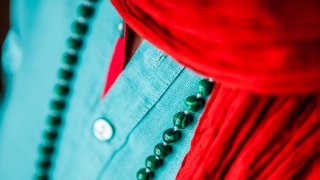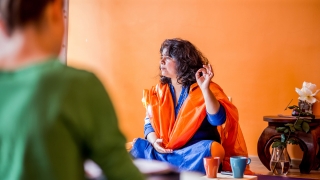Holi is the ultimate festival of colors from India. Surrounded by family, friends and community, we celebrate with food, colors and flowers the arrival of spring. Among these external layers of rituals and festivities lies the underlying current of Ayurveda, Tantra and Yoga. Every festival in India is a multilayered celebration. Let us see how these five layers unveil their colors on Holi.
- External layers of rituals to connect with community, the Physical Hue
- Personal layers of practices to align with the macrocosmic rhythm, pranic rhythm, for balance of doshas, the Pranic Hue
- Subtle layers of symbology that usher one to go deeper and anchor the restless mind, the Mental Hue
- Subtler layers of reflection, revision, redirection to inspire thinking and insight, the Intellectual Hue
- An eventual layer that ushers one to go beyond all possible layers and connect with Self, the Spiritual Hue
Do you see the interweaving of Yoga, Ayurveda, and Tantra through five koshas here in an ordinary festival? That is why these are not just practices set aside for Yogis, Tantrikas, Yoginis, and Ayurvedic Vaidyas. These are practices for all of humanity and in a very mundane way the eminent is shared, celebrated, and embodied.
Here are the five hues of Holi. In Holi, a.k.a. the festival of colors
- Physical Hue: One throws dry herbal powders of various colors on each other, and hugs everyone, saying “Happy Holi” or “Holi Mubarak” or “Holi ki hardika shubhkaamnaain.” I see it as a community-building exercise. I remember something that I heard from my parents in my childhood, which laid a deep impression on me. My father used to say, “This is the day to forget differences of all kinds and celebrate unity in diversity. Hug your enemy, too.” What a beautiful opportunity to come together, just like all the colors merge and create a wave of delight, may we set aside our opinions, thoughts, ideas, anything that separates us and creates otherness.
- Pranic Hue: The colors (called Gulal) are prepared from seasonal flowers, herbs, and spices like marigold, rose, neem, curry leaf, henna, turmeric, beets, Indigo etc. to give hues of red, pink, orange, green, and blue. These herbal powders, when they touch the body, are like an ubtan (herbal body powder) and prepares one for the shift of seasons from winter to spring. Most of these herbs are astringent and bitter, pacifying kapha dosha. See? This is embodied Ayurveda.
- Mental Hue: Consider this symbology: The word for color in Hindi is varna. Interestingly, the same word also means “syllable” (as in the 50 syllables in the Devanagari script), and also means type, order, class, species, quality, nature, etc.—basically all kinds of categorization. We can look at Holi as the celebration of different shades of humanity. On this particular day, we celebrate that diversity, that harmony among all these stratifications, and we celebrate it as one community. This is embodied Yoga.
- Intellectual Hue: Holi inspires one to see the colors as syllables. All possible words, mantras, shlokas, phrases, affirmations we speak; form is nothing but a string of varna—syllables. That is why all the 50 syllables are also called varna mala—the string of syllables—the string of colors. Shiva Sutras states, “Jnana adhisthanam matrika,” which means the syllables (called little mothers—matrika, here) are the basis of wisdom. On this Holi may we be showered with the wisdom contained in all the 50 colored/hued syllables. May all unknown become known to us. This is embodied Tantra.
- Spiritual Hue: Colors are vibrations. Such vibrations are the basis of our mind as thoughts, subtle body as pranic rhythm, and physical body as the heartbeat. When all wheels of colors dissolve into each other, the kundalini ascends from its inert state in Mooladhara to awakened state, crowing the mind of the being, and eventually descends and rests in its own nature in the heart of the heart. The consciousness rests in itself. May the colors remind us of such merging,dissolution, and eventual repose.
Happy Holi! May you see the dance of the syllables.
As the dot becomes lines and the lines curve and bend, may you experience the message each syllable as a color contains.
STAY IN TOUCH
Start your FREE subscription to Indu Arora's newsletter to get more on Yoga and Ayurveda here
Say hello on Instagram
Subscribe to my Youtube Channel.


![]() 4 minutes
•
3/6/23
4 minutes
•
3/6/23


